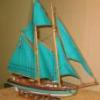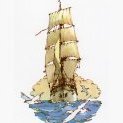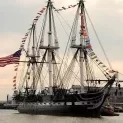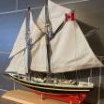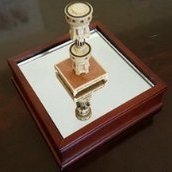HOLIDAY DONATION DRIVE - SUPPORT MSW - DO YOUR PART TO KEEP THIS GREAT FORUM GOING! (Only 20 donations so far - C'mon guys!)
×
-
Posts
2,611 -
Joined
-
Last visited
Reputation Activity
-
 JSGerson got a reaction from CaptainSteve in USS Constitution by JSGerson - Model Shipways Kit No. MS2040
JSGerson got a reaction from CaptainSteve in USS Constitution by JSGerson - Model Shipways Kit No. MS2040
So, I chose 0.032” (0.81mm) music wire for the stanchion because it won’t bend with normal handling. For the rope tab, the idea was to wrap a 0.005” thick brass strip around the wire and then glue the ends together to form the tab. Lastly, drill a hole in the tab with a #78 drill bit to create a rope hole. Everything went according to plan…until it didn’t. For the life of me, I could not create the rope hole. My drill bit bent if I applied any pressure. (Cheap bits, I don’t know?) I tried creating a dimple into the brass with a needle for the bit to bite into, but all that did was deform the thin strip. I even tried using a very fine cone shape grinding bit but couldn’t keep it perfectly centered on the brass strip. It would drift and eat away one side or the other of the strip making the strip useless.
-
 JSGerson got a reaction from CaptainSteve in USS Constitution by JSGerson - Model Shipways Kit No. MS2040
JSGerson got a reaction from CaptainSteve in USS Constitution by JSGerson - Model Shipways Kit No. MS2040
Getting back to the gun rigging, I decided to plunge in and complete the rigging once and for all. I just wanted to get it over and done with. Adding 22 fully rigged guns was no simple task. I made the following calculations and was staggered by what it revealed. From start to finish, adding eyebolts to the interior of the gun deck, to fabricating and assembling the gun trucks, and then rigging them, I got the following numbers:
There are 235 separate parts per gun port or 5,170 parts for 22 fully rigged guns not counting brass blackening, painting, and do-overs. Most of these had to be fabricated from scratch. That breaks downs as follows:
Gun & Truck = 26 pieces/gun = 572 pieces total
Item Quantity
Gun 1
Sides 2
Axials 2
Wheels 4
Transom 1
Breast Piece 1
Quion 1
Quion Handle 1
Quion Bed 1
Trunnion cap 2
Eyebolts 8
Rings 2
Gun Ropes (including excess waste)
Ropes/gun: 10 cut pieces/gun = 220 pieces of rope total
Recoil Rope. 1-6” piece 0.030” (0.76mm) dia./gun x 22 guns = 66 pieces = 132” = 11’ = 3.6 yds total
Tackle Ropes w/coils 7” piece 0.018” (0.45mm) dia. + 1.5” (for double block)/tackle + coil = 8.5”/tackle + 1 rope coil x 3 tackles + coils/gun” = 7 pieces of rope/gun = 3 Tackles +3 coils/gun @ 25.5”/ gun = 154 pieces of rope = 561” = 47’ ~ 16 yds total for 66 tackles + 66 coils = 3,388 pieces total
Rope Seizings/gun: = 21 rope seizings/gun = 462 seizings total = 3 yds thread total
Recoil rope seizings 6 seizings/piece = 24” of thread = 2’ total/recoil rope
Tackle seizings 5 seizings (@4”/seizings) /tackle = 20” thread/tackle rope
3 tackles/gun = 15 seizings = 5’ thread/gun = 3 yards thread total
Note: rope coils made from excess rope and supplemented with additional rope
3 Tackles/gun = 6 blocks/gun = 132 blocks total
3/32” Single blocks 1/tackle @ 3 tackles/gun =3 blocks/gun = 66 blocks total
3/32” Double blocks 1/tackle @ 3 tackles/gun = 3 blocks/gun = 66 blocks total
Block hooks 6/gun = 132 hooks total
Gun Ports = 12 parts/port = 222 total
Eyebolts: 10/port = 220 total:
Recoil Rope eyebolts/port 4 = 88 total
Tackle double eyebolts/port 2 = 44 total
Idle eyebolts/port 3 = 66 total
Deck tackle eyebolt 1 = 22 total
Recoil rope bulkhead pins 2/port = 44 total
All gun deck guns are now rigged!!! Whew!!! As I promised, an OSHA nightmare.
-
 JSGerson got a reaction from Der Alte Rentner in USS Constitution by Der Alte Rentner - Model Shipways - 1/76
JSGerson got a reaction from Der Alte Rentner in USS Constitution by Der Alte Rentner - Model Shipways - 1/76
I did you one better. After I made my rudder, I set it aside in a box to be used later when I was ready to add its hinges. Then I used it to help formulate and fabricate the hinge axial, pintles, and gudgeons. When I was ready to install them on the rudder, I couldn't find the rudder. Now a rudder is not an easy thing to lose. Yet after weeks of looking I gave up because I didn't want to waste more time looking and so I fabricated a new one and installed it as you see it today. Then about a week later, the original one reappeared innocently sitting on my workbench just behind the model. I know I checked the workbench thoroughly and it was gone. Now it's back. A total mystery in the saga of ship model builders.
Jon
-
 JSGerson got a reaction from Stevenleehills in USS Constitution by Der Alte Rentner - Model Shipways - 1/76
JSGerson got a reaction from Stevenleehills in USS Constitution by Der Alte Rentner - Model Shipways - 1/76
I did you one better. After I made my rudder, I set it aside in a box to be used later when I was ready to add its hinges. Then I used it to help formulate and fabricate the hinge axial, pintles, and gudgeons. When I was ready to install them on the rudder, I couldn't find the rudder. Now a rudder is not an easy thing to lose. Yet after weeks of looking I gave up because I didn't want to waste more time looking and so I fabricated a new one and installed it as you see it today. Then about a week later, the original one reappeared innocently sitting on my workbench just behind the model. I know I checked the workbench thoroughly and it was gone. Now it's back. A total mystery in the saga of ship model builders.
Jon
-
 JSGerson got a reaction from Russ2025 in USS Constitution by Der Alte Rentner - Model Shipways - 1/76
JSGerson got a reaction from Russ2025 in USS Constitution by Der Alte Rentner - Model Shipways - 1/76
I did you one better. After I made my rudder, I set it aside in a box to be used later when I was ready to add its hinges. Then I used it to help formulate and fabricate the hinge axial, pintles, and gudgeons. When I was ready to install them on the rudder, I couldn't find the rudder. Now a rudder is not an easy thing to lose. Yet after weeks of looking I gave up because I didn't want to waste more time looking and so I fabricated a new one and installed it as you see it today. Then about a week later, the original one reappeared innocently sitting on my workbench just behind the model. I know I checked the workbench thoroughly and it was gone. Now it's back. A total mystery in the saga of ship model builders.
Jon
-
 JSGerson got a reaction from mtbediz in USS Constitution by Der Alte Rentner - Model Shipways - 1/76
JSGerson got a reaction from mtbediz in USS Constitution by Der Alte Rentner - Model Shipways - 1/76
I did you one better. After I made my rudder, I set it aside in a box to be used later when I was ready to add its hinges. Then I used it to help formulate and fabricate the hinge axial, pintles, and gudgeons. When I was ready to install them on the rudder, I couldn't find the rudder. Now a rudder is not an easy thing to lose. Yet after weeks of looking I gave up because I didn't want to waste more time looking and so I fabricated a new one and installed it as you see it today. Then about a week later, the original one reappeared innocently sitting on my workbench just behind the model. I know I checked the workbench thoroughly and it was gone. Now it's back. A total mystery in the saga of ship model builders.
Jon
-
 JSGerson got a reaction from mtbediz in USS Constitution by Der Alte Rentner - Model Shipways - 1/76
JSGerson got a reaction from mtbediz in USS Constitution by Der Alte Rentner - Model Shipways - 1/76
I think you misread my post. I have no intentions of rigging the rudder to be activated by the ship's wheel. Once the rudder is in position in the display case, that's it, I'm done.😁
-
 JSGerson got a reaction from Stevenleehills in USS Constitution by Der Alte Rentner - Model Shipways - 1/76
JSGerson got a reaction from Stevenleehills in USS Constitution by Der Alte Rentner - Model Shipways - 1/76
My mental concept is to displayed one anchor hanging from a cathead with the double linked chain I bought on the web some years past, one anchor also hanging on the other cathead but with the cable, and the third stored on deck alone. I don't know how accurate that is, but does show off the various possibilities.
Jon
-
 JSGerson got a reaction from Der Alte Rentner in USS Constitution by Der Alte Rentner - Model Shipways - 1/76
JSGerson got a reaction from Der Alte Rentner in USS Constitution by Der Alte Rentner - Model Shipways - 1/76
My mental concept is to displayed one anchor hanging from a cathead with the double linked chain I bought on the web some years past, one anchor also hanging on the other cathead but with the cable, and the third stored on deck alone. I don't know how accurate that is, but does show off the various possibilities.
Jon
-
 JSGerson got a reaction from GGibson in USS Constitution by Der Alte Rentner - Model Shipways - 1/76
JSGerson got a reaction from GGibson in USS Constitution by Der Alte Rentner - Model Shipways - 1/76
My mental concept is to displayed one anchor hanging from a cathead with the double linked chain I bought on the web some years past, one anchor also hanging on the other cathead but with the cable, and the third stored on deck alone. I don't know how accurate that is, but does show off the various possibilities.
Jon
-
 JSGerson got a reaction from tmj in USS Constitution by JSGerson - Model Shipways Kit No. MS2040
JSGerson got a reaction from tmj in USS Constitution by JSGerson - Model Shipways Kit No. MS2040
I then went on and added the remaining tackle. At this point, nothing is glued in place, and the lines are not neatly coiled up and positioned yet. The last three guns on each side of the stern will have a fifth tackle to pull back the gun slide where the spar deck is not cut away as seen in the last photo below. This last tackle is not installed on the actual ship as they are tourist tripping hazards in the modern world.
-
 JSGerson got a reaction from GGibson in USS Constitution by g8rfan99 - BlueJacket Shipcrafters - 1/98
JSGerson got a reaction from GGibson in USS Constitution by g8rfan99 - BlueJacket Shipcrafters - 1/98
You are correct, those are the fun things to make. The gun deck has lots of these gem mini-models to fabricate. Too bad very few of them will be visible enough for observers to see and appreciate fully.
Jon
-
 JSGerson got a reaction from Unegawahya in USS Constitution by JSGerson - Model Shipways Kit No. MS2040
JSGerson got a reaction from Unegawahya in USS Constitution by JSGerson - Model Shipways Kit No. MS2040
I then went on and added the remaining tackle. At this point, nothing is glued in place, and the lines are not neatly coiled up and positioned yet. The last three guns on each side of the stern will have a fifth tackle to pull back the gun slide where the spar deck is not cut away as seen in the last photo below. This last tackle is not installed on the actual ship as they are tourist tripping hazards in the modern world.
-
 JSGerson got a reaction from Unegawahya in USS Constitution by JSGerson - Model Shipways Kit No. MS2040
JSGerson got a reaction from Unegawahya in USS Constitution by JSGerson - Model Shipways Kit No. MS2040
As is my masochistic custom of following the more difficult path, I chose to attach the recoil rope to the bulwark like I did on the gun deck by inserting the rope loop between two eyebolts mounted one above the other when the bulwarks were installed many years ago. Then a short drop bolt is inserted into the top eyebolt, though the rope loop, and out the bottom eyebolt. The drop bolt was made from a 3/8” long 0.025” shaft diameter flathead nail which was cut to 1/8” length. I apologize for the out of focus image. A zero depth of field, in a confined space, with a shaky hand are not a good mix. I didn’t realize I had a poor-quality photo till I was composing this post. So, I demonstrated the process using my gun port mockup.
-
 JSGerson got a reaction from Unegawahya in USS Constitution by JSGerson - Model Shipways Kit No. MS2040
JSGerson got a reaction from Unegawahya in USS Constitution by JSGerson - Model Shipways Kit No. MS2040
Using the mockup gun port I originally made for the gun deck; I fabricated the recoil rope and a set of typical tackles. The blocks, both single and double were 3/32”, the tackle rope was tan 0.008” (0.028 mm), and the recoil rope was Ultra tan 0.030” (.76 mm), all from Syren Ship Model Co. As previously mentioned in the prior post, the seizing line was the 3/0 nylon rigging line from the kit. Once I was happy with first completed set, I made just the recoil ropes for all 20 carronades first.
While seizing the loops, I noticed quite quickly that the loop would not pass through the recoil rings already attached to the guns. The rope loops were just not flexible enough at this scale. Therefore, after seizing the first loop, the recoil rope was threaded through the rings on the gun with the “un-looped” end first. Then the free end was seized creating the second loop.
-
 JSGerson got a reaction from Unegawahya in USS Constitution by Der Alte Rentner - Model Shipways - 1/76
JSGerson got a reaction from Unegawahya in USS Constitution by Der Alte Rentner - Model Shipways - 1/76
From what I surmised from the images Ken provided, he did not attached the deadeyes to the chain plates. He twisted the wires stropping the deadeyes creating a tail which was then inserted into the channel. The chain plates were laid on top of the tails and extended to the hull. The "joint" was eventually covered over by the channel cap hiding the false connection. A little bit of modeler's sleight of hand.
-
 JSGerson got a reaction from Stevenleehills in USS Constitution by mtbediz - 1:76
JSGerson got a reaction from Stevenleehills in USS Constitution by mtbediz - 1:76
If I have a picture, I will share it. Just ask.
Jon
-
 JSGerson got a reaction from Der Alte Rentner in USS Constitution by mtbediz - 1:76
JSGerson got a reaction from Der Alte Rentner in USS Constitution by mtbediz - 1:76
If I have a picture, I will share it. Just ask.
Jon
-
 JSGerson got a reaction from PaddyO in USS Constitution by mtbediz - 1:76
JSGerson got a reaction from PaddyO in USS Constitution by mtbediz - 1:76
If I have a picture, I will share it. Just ask.
Jon
-
 JSGerson got a reaction from mtbediz in USS Constitution by mtbediz - 1:76
JSGerson got a reaction from mtbediz in USS Constitution by mtbediz - 1:76
If I have a picture, I will share it. Just ask.
Jon
-
 JSGerson got a reaction from mtbediz in USS Constitution by GGibson - Model Shipways - 1:76.8
JSGerson got a reaction from mtbediz in USS Constitution by GGibson - Model Shipways - 1:76.8
So far, so good.
Jon
-
 JSGerson got a reaction from Stevenleehills in USS Constitution by JSGerson - Model Shipways Kit No. MS2040
JSGerson got a reaction from Stevenleehills in USS Constitution by JSGerson - Model Shipways Kit No. MS2040
I then went on and added the remaining tackle. At this point, nothing is glued in place, and the lines are not neatly coiled up and positioned yet. The last three guns on each side of the stern will have a fifth tackle to pull back the gun slide where the spar deck is not cut away as seen in the last photo below. This last tackle is not installed on the actual ship as they are tourist tripping hazards in the modern world.
-
 JSGerson got a reaction from Stevenleehills in USS Constitution by JSGerson - Model Shipways Kit No. MS2040
JSGerson got a reaction from Stevenleehills in USS Constitution by JSGerson - Model Shipways Kit No. MS2040
As is my masochistic custom of following the more difficult path, I chose to attach the recoil rope to the bulwark like I did on the gun deck by inserting the rope loop between two eyebolts mounted one above the other when the bulwarks were installed many years ago. Then a short drop bolt is inserted into the top eyebolt, though the rope loop, and out the bottom eyebolt. The drop bolt was made from a 3/8” long 0.025” shaft diameter flathead nail which was cut to 1/8” length. I apologize for the out of focus image. A zero depth of field, in a confined space, with a shaky hand are not a good mix. I didn’t realize I had a poor-quality photo till I was composing this post. So, I demonstrated the process using my gun port mockup.
-
 JSGerson got a reaction from Stevenleehills in USS Constitution by JSGerson - Model Shipways Kit No. MS2040
JSGerson got a reaction from Stevenleehills in USS Constitution by JSGerson - Model Shipways Kit No. MS2040
Using the mockup gun port I originally made for the gun deck; I fabricated the recoil rope and a set of typical tackles. The blocks, both single and double were 3/32”, the tackle rope was tan 0.008” (0.028 mm), and the recoil rope was Ultra tan 0.030” (.76 mm), all from Syren Ship Model Co. As previously mentioned in the prior post, the seizing line was the 3/0 nylon rigging line from the kit. Once I was happy with first completed set, I made just the recoil ropes for all 20 carronades first.
While seizing the loops, I noticed quite quickly that the loop would not pass through the recoil rings already attached to the guns. The rope loops were just not flexible enough at this scale. Therefore, after seizing the first loop, the recoil rope was threaded through the rings on the gun with the “un-looped” end first. Then the free end was seized creating the second loop.
-
 JSGerson got a reaction from Nirvana in USS Constitution by JSGerson - Model Shipways Kit No. MS2040
JSGerson got a reaction from Nirvana in USS Constitution by JSGerson - Model Shipways Kit No. MS2040
I then went on and added the remaining tackle. At this point, nothing is glued in place, and the lines are not neatly coiled up and positioned yet. The last three guns on each side of the stern will have a fifth tackle to pull back the gun slide where the spar deck is not cut away as seen in the last photo below. This last tackle is not installed on the actual ship as they are tourist tripping hazards in the modern world.


